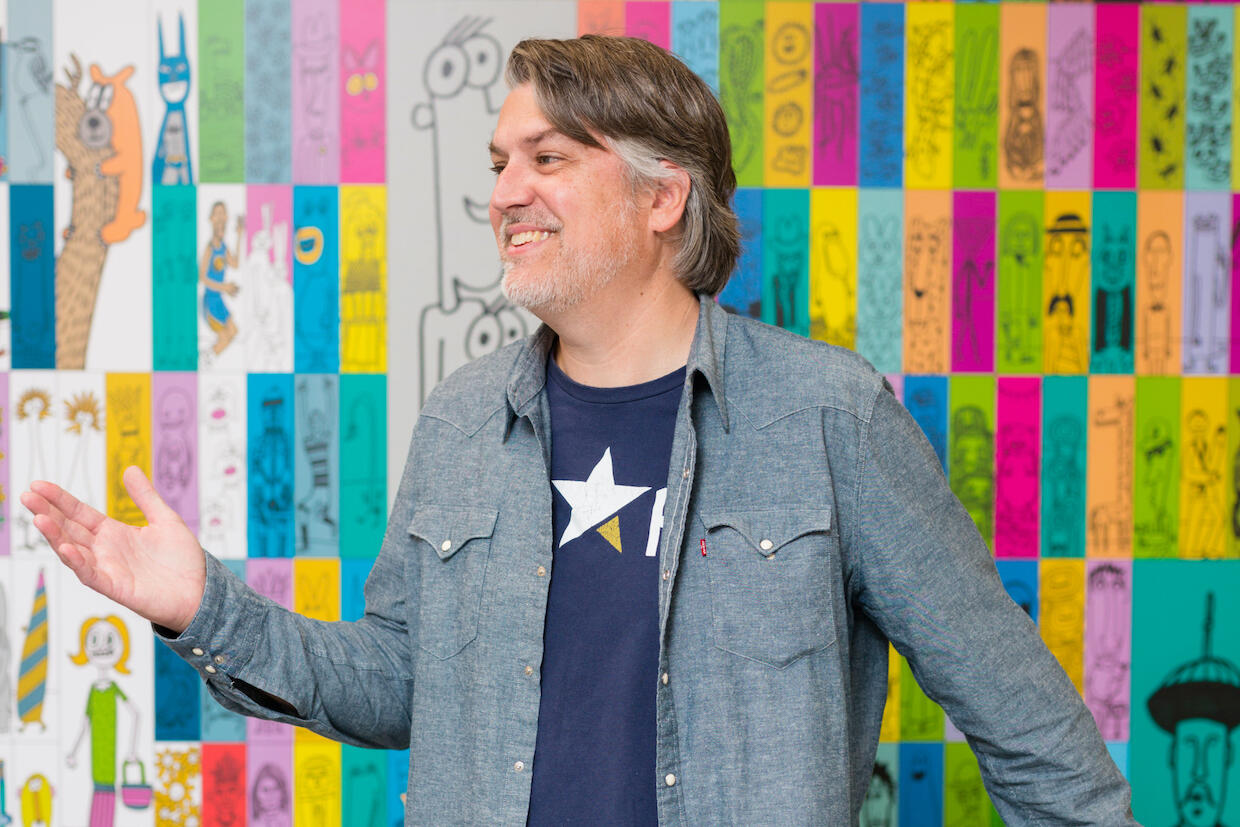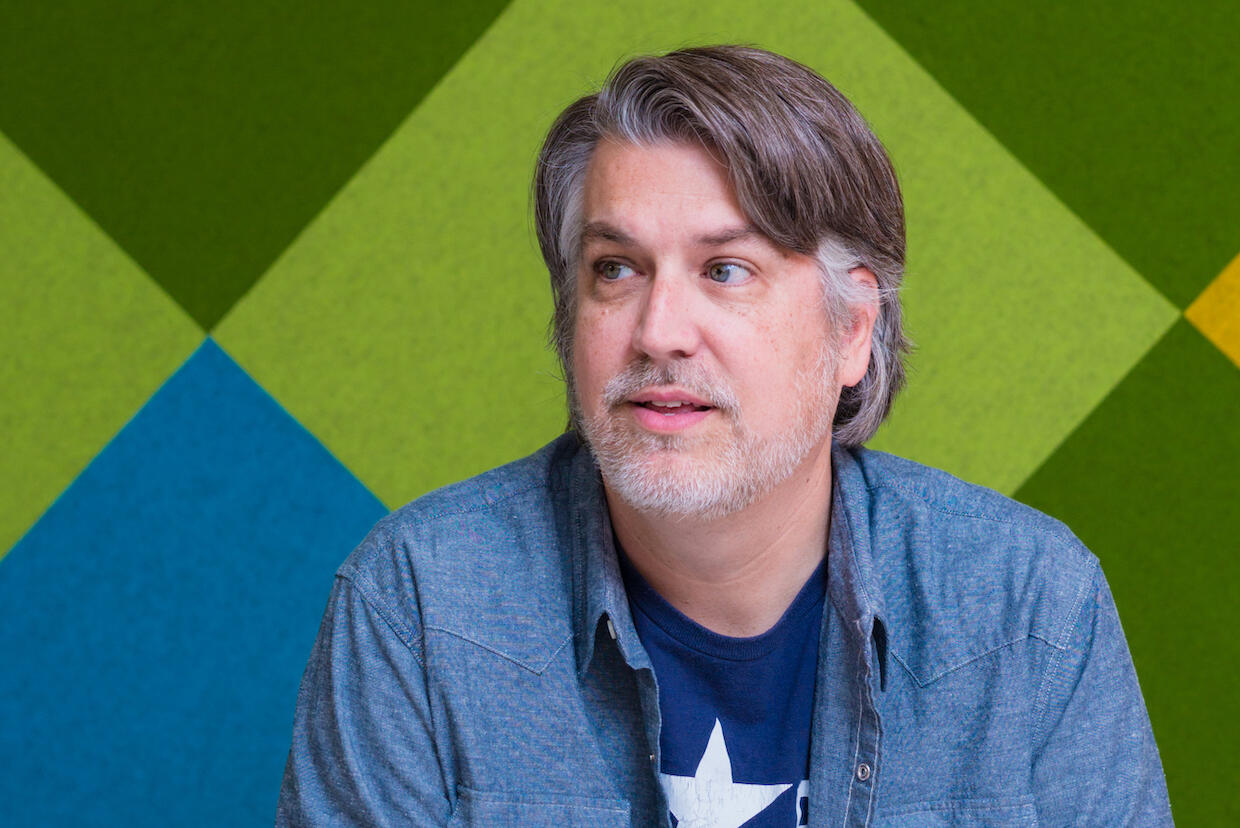
June 1, 2021
Creating something ‘magical’: Alum’s passion for doodling leads to murals at children’s hospital
Share this story
Marius Valdes’ childhood memories of exploring the zoo and wooded trails at Charles Towne Landing State Historic Site in South Carolina, and his ongoing obsession with doodling came together when he created five wall-size murals for the Medical University of South Carolina Shawn Jenkins Children’s Hospital.
His first mural for the hospital, which he completed last summer, contained 200 drawings of animals in South Carolina and measured 140 feet by 8 feet. He was familiar with the animals from his visits to the zoo at Charles Towne.
“Most of my work is animal or character based,” said Valdes, who earned a master’s of fine arts degree in 2005 from the Virginia Commonwealth University School of the Arts. “The administrators of the hospital felt like they needed something to transform a busy area on the seventh floor. All of these pieces have become visual cues.”
The hospital gave Valdes artistic flexibility and allowed him to do whatever he felt would be the best design. All of the art was done by hand and scanned into a computer. A local printer created the art digitally on material that was installed like wallpaper.
“By printing on material, you can wash it or wipe it down and it won’t mess up,” Valdes said.
Finding his inspiration
Valdes cultivated a curiosity for art when he was growing up in Charleston, South Carolina. His father would bring home pads of paper from work and Valdes would watch television and draw.
“As I got older, I got interested in art classes, but I was more interested in basketball and it won out,” he said. “I always doodled. I would draw basketball players, the Sunday comics and cartoons. I could draw a very good Bugs Bunny. I loved to doodle, and that is still my primary way of working and thinking.”
A self-described introvert, Valdes said he can get lost in his imagination and slip into his own world when doodling.
“I like the way the pen feels as it moves across the paper. I like to take a blank piece of paper and create something with my imagination that is magical,” he said. “I have always drawn what I like.”
<slideshow id=206 align=center width=600>
When Valdes was pursuing a bachelor’s degree in graphic design at the University of Georgia, he became interested in illustration once he understood what defined the medium.
“When I would design something for my design classes, I gravitated toward hand drawing,” he said. “My first year out of college I didn’t own a television, and I was living by myself. I started painting for fun.”
During that time he discovered the book “Raw Creation: Outsider Art & Beyond” by John Maizels, which focuses on art created outside the confines of traditional art.
“That really affected me,” Valdes said. “College design is all about rules. When I started looking at outsider artists, I was drawn to painting. It inspired me to start painting for fun, for entertainment. I started finger painting on cardboard. I enjoyed that because it was raw and there were no rules.”
Canvases of cardboard
Before long, Valdes was dumpster diving at a local appliance store for refrigerator boxes because the large cardboard frames could be cut into canvases. He gave away his first cardboard paintings. Word got out and the Charleston music venue Music Farm asked him to make some wall-size calendars for bands coming to the venue.
“I made about 300 of these paintings in a year,” he said. “I started doing more work in Charleston and for the first time won a design award, the ADDY Award, from the Charleston chapter of South Carolina Advertising Federation, for my finger paintings on cardboard.
“I realized that people valued that I put my own character into the work. It was more personal, more like me as opposed to graphic design, which is more about what the client wants.”
Valdes’ projects have been recognized with numerous awards, including three Graphic Design USA Magazine awards for his hospital murals. He is currently working on a grant-funded children’s book featuring animals in the hospital mural that can be given to pediatric patients.

Finding his way in life
Valdes was making cardboard paintings when he entered graduate school at VCU in 2003.
“I felt like I needed someone to help me figure out what I was doing with art. I am a good designer but my strength is making art in characters,” he said. “The design faculty at VCU was really great. They helped me think about my work differently. That led to me making clay creations and thinking about storytelling. I didn’t know how to talk about the work I was making. I wanted to understand and communicate to people what I am doing.”
He was inspired by several professors in the School of Arts.
“They were all doing some interesting things,” he said. “Sandy Wheeler, associate professor of graphic design, was my go-to person. Matt Woolman, a professor in the Department of Graphic Design and executive director of the VCUarts Center for the Creative Economy, opened my eyes to all the things you could do. I have structured my own teaching on professor Wheeler, Rob Carter, professor emeritus in communication arts and design, and Roy McKelvey, associate professor of graphic design.”
Valdes, who lives in Columbia, South Carolina, with his wife, Beth, and 14-year-old daughter, Emma, is now an associate studio arts professor at the University of South Carolina, teaching graphic design and illustration classes.
“I will be promoted to full professor next year,” he said. “The best thing about academia is that I teach, but I have time to make work and I’m very active in both. It’s a good balance. I got lucky. I found the perfect job.”
Subscribe to VCU News
Subscribe to VCU News at newsletter.vcu.edu and receive a selection of stories, videos, photos, news clips and event listings in your inbox.







